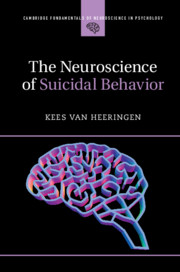Book contents
- Frontmatter
- Dedication
- Contents
- Figures
- Tables
- Preface
- Chapter One What Is Suicidal Behavior, and Can It Be Prevented?
- Chapter Two Stress, Vulnerability, and Suicide
- Chapter Three The Dark Side of the Brain
- Chapter Four Lethal Signals
- Chapter Five I Think, Therefore I Do Not Want to Be
- Chapter Six Images of the Suicidal Brain
- Chapter Seven “In my end is my beginning”
- Chapter Eight I Predict, Therefore I Cannot Be
- Chapter Nine Predicting the Unpredictable
- Chapter Ten The Treatment of Suicide Risk
- Glossary
- References
- Index
- Colour Plates
Chapter Three - The Dark Side of the Brain
Neuroscience Approaches to Suicidal Behavior
Published online by Cambridge University Press: 22 May 2019
- Frontmatter
- Dedication
- Contents
- Figures
- Tables
- Preface
- Chapter One What Is Suicidal Behavior, and Can It Be Prevented?
- Chapter Two Stress, Vulnerability, and Suicide
- Chapter Three The Dark Side of the Brain
- Chapter Four Lethal Signals
- Chapter Five I Think, Therefore I Do Not Want to Be
- Chapter Six Images of the Suicidal Brain
- Chapter Seven “In my end is my beginning”
- Chapter Eight I Predict, Therefore I Cannot Be
- Chapter Nine Predicting the Unpredictable
- Chapter Ten The Treatment of Suicide Risk
- Glossary
- References
- Index
- Colour Plates
Summary
The essence of the neurobiology of suicidal behavior is that a specific vulnerability to suicidal behavior is mediated by an underlying genetic predisposition interacting with environmental stressors and probable epigenetic factors throughout the lifespan to modify the function of neuronal circuits, thus rendering an individual more likely to engage in a suicidal act.
This chapter will introduce the methods by which the behaviors and models discussed in the previous two chapters are studied. This chapter will thus provide the reader with a foundation of neuroscience techniques from which they can build upon with information in the remainder of the book. These techniques address (epi-)genetics and functional neuro-anatomy.
Neuroscience approaches to the study and understanding of suicidal behavior may differ somewhat from those targeting other behavioral issues. As suicide appears to be a unique human behavior, there is a lack of animal models. However, much information is available from postmortem studies of brain tissue, in which brain characteristics of suicide victims are compared to those of individuals who died from other causes. Postmortem studies are sometimes accompanied by psychological autopsies, which are standardized interviews with individuals who were in close contact with the deceased, covering a wide range of health- and personality-related issues.
Keywords
Information
- Type
- Chapter
- Information
- The Neuroscience of Suicidal Behavior , pp. 40 - 62Publisher: Cambridge University PressPrint publication year: 2018
